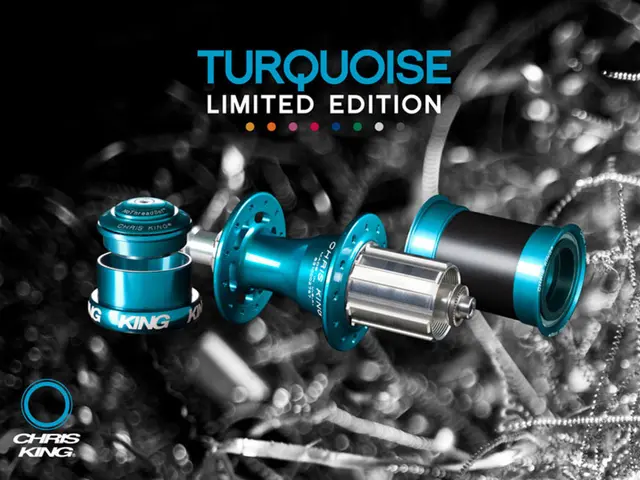Pioneering Lung Cancer Therapy with RAU-Net: Innovative Approach to Cancer Treatment
Revamping Cancer Detection: The Game-Changer Called RAU-Net
Unleash your curiosity as we delve into the groundbreaking advancements in the world of artificial intelligence (AI) and healthcare. Meet RAU-Net, a revolutionary model that's transforming lung cancer diagnostics and treatment planning. Say goodbye to lengthy, error-prone manual processes, as this intelligent tech promises faster, more accurate, and reliable cancer detection. With lung cancer still claiming countless lives, early diagnosis is crucial. RAU-Net offers a fresh, efficient solution by marrying deep learning with attention-based architectures. Here's your bird's-eye view of how this marvel is changing the game forever.
Also Check Out: Artificial Intelligence: Reinventing Cancer Treatment*
Highlights
- Lung Cancer Diagnostics revolutionized by RAU-Net
- The detrimental effects of late lung cancer detection are countered with early diagnosis and swift intervention
- RAU-Net: a state-of-the-art model pairing deep learning with attention mechanisms, refining lung tumor detection and segmentation in CT scans
The Urgency of Early Lung Cancer Detection
Lung cancer remains a leading cause of cancer-related deaths worldwide. Prompt diagnosis is the secret weapon to improved survival rates and optimized treatment outcomes. Despite advancements in diagnostic imaging like CT scans, manual interpretation remains laborious and prone to human error.
Medical professionals, including radiologists, grapple with identifying lung nodules, due to the complexity of imaging data. Machine learning tools have stepped in to streamline this process, but many models still fall short when it comes to distinguishing between malignant and benign tumors. This gap underscores the need for robust algorithms to elevate diagnostic accuracy and provide consistent interpretations, a role RAU-Net was born to play.
RAU-Net: Your Lung Cancer Fighting Partner
RAU-Net-known as Residual Attention U-Net-is a deep learning architecture designed to detect and segment lung tumors using CT scans. It builds upon the widely recognized U-Net model, a convolutional neural network optimized for biomedical image segmentation. RAU-Net distinguishes itself by integrating two vital components: residual learning and attention mechanisms.
The model inputs a lung CT scan and outputs a segmented image, where tumor regions are highlighted for further analysis. RAU-Net demonstrates outstanding generalization capabilities, making it useful and versatile across multiple patient demographics and scan types.
How RAU-Net Boosts Medical Image Segmentation
RAU-Net's success can be attributed to its exceptional segmentation performance metrics. In thorough testing, it recorded impressive Dice Similarity Coefficient (DSC) scores and Intersection over Union (IoU) values. High scores indicate that the model's predicted tumor regions closely align with the expert-annotated ground truths, highlighting its ability to detect and classify tumor boundaries with precision.
Two primary architectural features fueling its success are residual units and attention modules. Residual units preserve gradient flows during training and prevent accuracy degradation as the network deepens. Attention modules guide the network to prioritize important areas in the scan, enabling it to pay attention only to lung nodules and disregard unimportant features like blood vessels or chest wall boundaries. Furthermore, RAU-Net implements multi-scale feature fusion, uniting shallow and deep feature maps to improve prediction capabilities, resulting in clearer distinctions between tumor and non-tumor regions.
Also See: AI to the Rescue: Revolutionizing Breast Cancer Screenings*
Clinch Better Diagnostic Outcomes and Treatment Planning with RAU-Net
RAU-Net's impacts in clinical settings are significant. Precise segmentation allows oncologists to make better surgical decisions and develop more effective radiation therapy plans. Radiologists will also be able to rely on the model for double-checking manual annotations or speeding up diagnosis in high-volume scenarios.
In addition, RAU-Net may be integrated into clinical decision support systems, offering second-opinion assessments for complex cases. By reducing manual workload, clinicians can prioritize patient care, as well as bridge healthcare disparities in rural or under-resourced areas where expert radiologists are unavailable.
What Sets RAU-Net Apart: Training Techniques that Make a Difference
RAU-Net benefits from a rigorous training pipeline. It is trained on publicly available lung CT scan datasets like LUNA16 and LIDC-IDRI, both respected in the medical AI field. Data augmentation techniques, such as rotation, flipping, and scaling, have been employed to train RAU-Net under a variety of imaging scenarios, improving its robustness in different imaging qualities and patient profiles. The model also employs loss functions tailored for class imbalance, a common issue in medical data where tumor regions are often smaller than non-tumor ones.
This training design ensures that RAU-Net maintains consistent performance even when exposed to new or unseen data, essential for real-world deployment in hospitals and diagnostic labs.
Traditional Models vs. RAU-Net
Pre-RAU-Net models such as vanilla U-Net and SegNet tried to tackle tumor detection with limited success. While these models laid the groundwork for medical imaging automation, they often struggled with accurate segmentation in complicated scans due to their lack of attention mechanisms.
RAU-Net surpasses these older networks by focusing more effectively on relevant image regions and combining features across different layers. Even advanced models like ResUNet++ do not match RAU-Net's balance between speed and accuracy. Its computational efficiency also makes it suitable for real-time inference, a considerable advantage in emergency diagnostic settings.
Comparative studies demonstrate that incorporating channel-spatial attention mechanisms produces higher-quality segmentations, especially when handling obscure tumor boundaries or overlapping tissues-a significant limitation with traditional architectures.
Also Explore: AI at the Forefront: Amplifying Breast Cancer Detection*
The Future of RAU-Net in Medical AI Landscape
With its robust and flexible architecture, RAU-Net paves the way for even more advanced AI models in oncology. Researchers now investigate the model's potential in detecting tumors in various organs, such as the liver, brain, and pancreas. As data grows, and training datasets become more diverse, the model continues to improve, expanding its scope and accuracy.
Integration into clinical workflows will also involve real-time imaging and cross-platform compatibility with electronic health record systems. As machine learning engineers optimize RAU-Net for mobile and cloud deployment, low-resource facilities can leverage its capabilities without requiring expensive hardware setups.
The adoption rate depends heavily on regulatory approvals, reliability benchmarks, and cooperation between engineers and clinical practitioners, but the momentum is strong. RAU-Net marks a crucial milestone on the road to smarter, AI-driven healthcare solutions.
Conclusion
RAU-Net redefines lung cancer treatment and diagnostic technologies. By merging deep learning, attention mechanisms, and medical expertise, it delivers exceptional results, offering hope and a smart solution for a critical healthcare challenge. With its precision and speed, it promises a brighter future for early detection, clinical decision support, and improved patient outcomes. As research progresses, expect RAU-Net to continue pushing the frontiers of AI-powered healthcare.
References
- Parker, Prof. Philip M., Ph.D. "The 2025-2030 World Outlook for Artificial Intelligence in Healthcare.", INSEAD, 3 Mar. 2024.
- Khang, Alex, editor. "AI-Driven Innovations in Digital Healthcare: Emerging Trends, Challenges, and Applications.", IGI Global, 9 Feb. 2024.
- Singla, Babita, et al., editors. "Revolutionizing the Healthcare Sector with AI.", IGI Global, 26 July 2024.
- Topol, Eric J. "Deep Medicine: How Artificial Intelligence Can Make Healthcare Human Again.", Basic Books, 2019.
- Nelson, John W., editor, et al. "Using Predictive Analytics to Improve Healthcare Outcomes.", 1st ed., Apress, 2021.
- Subbhuraam, Vinithasree. "Predictive Analytics in Healthcare, Volume 1: Transforming the Future of Medicine.", 1st ed., Institute of Physics Publishing, 2021.
- Kumar, Abhishek, et al., editors. "Evolving Predictive Analytics in Healthcare: New AI Techniques for Real-Time Interventions.", The Institution of Engineering and Technology, 2022.
- Tetteh, Hassan A. "Smarter Healthcare with AI: Harnessing Military Medicine to Revolutionize Healthcare for Everyone, Everywhere.", ForbesBooks, 12 Nov. 2024.
- Lawry, Tom. "AI in Health: A Leader’s Guide to Winning in the New Age of Intelligent Health Systems.", 1st ed., HIMSS, 13 Feb. 2020.
- Holley, Kerrie, & Manish Mathur. "LLMs and Generative AI for Healthcare: The Next Frontier.", 1st ed., O’Reilly Media, 24 Sept. 2024.
- Holley, Kerrie, & Siupo Becker M.D. "AI-First Healthcare: AI Applications in the Business and Clinical Management of Health.", 1st ed., O’Reilly Media, 25 May 2021.
- By embracing deep learning and attention-based architectures, RAU-Net is revolutionizing the medical-conditions sector, specifically in diagnosing and treating cancer, particularly lung cancer.
- The integration of RAU-Net into healthcare technology presents numerous advantages, such as faster, more accurate, and reliable cancer detection, leading to improved health-and-wellness outcomes for patients.
- With its exceptional segmentation performance metrics, RAU-Net outperforms traditional models in detecting and classifying tumor boundaries with precision, which is crucial for early and accurate cancer detection.
- The deployment of RAU-Net in real-world settings involves regulatory approvals, reliability benchmarks, and cooperation between engineers and clinical practitioners. However, with continued research and optimizations, RAU-Net holds significant potential for transforming the AI landscape in healthcare and saving lives.





